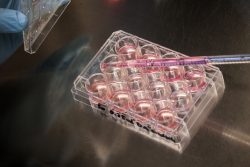 In a global-first, researchers from Chinese Academy of Sciences and BGI-Research and other partners, have announced the discovery of a rapid, transgene-free, and controllable way to change pluripotent stem cells into authentic 8 cell totipotent embryo-like cells. This paves the way for future advances in synthetic biology and regeneration of organs.
In a global-first, researchers from Chinese Academy of Sciences and BGI-Research and other partners, have announced the discovery of a rapid, transgene-free, and controllable way to change pluripotent stem cells into authentic 8 cell totipotent embryo-like cells. This paves the way for future advances in synthetic biology and regeneration of organs.
The teams used the technologies of advanced single-cell sequencing from BGI to assist in changing pluripotent stem cells or an adult type of early embryonic cells into a juvenile type. This ensures that it will activate human zygotic genome and keep all the lineage along with the potential of development.
The cells could possibly be useful in prospective regenerative medicine for human organs that are diseased and would also reduce the reliance on donation of organs. They could be used to build artificial blastoids and blastocysts. They also would be useful in the study of human embryonic development, prevent pregnancy loss and help treat related diseases that develop early.
This technology that changes pluripotent stem cells into inner cell mass-like cells inside the blastocyst has been around for a while. In this new study scientists have been able to establish methods that change pluripotent stem cells to an early phase in the human development cycle that equals the 8 cell embryo. This will provide insight into the development of the human embryonic system. Essentially the team showed that the cells that were converted could create placental cells in vivo which is the only time this has been achieved.
Totipotent 8 cell stage embryo like cells recreate an embryonic state of an egg that has been fertilized following only three divisions. In comparison to the reported pluripotent stem cells, these distinct cells will not only change into placental tissue, but can possibly develop into a more mature organ which is good news for the number of patients needing transplants all over the globe.
The breakthrough is in addition a great portrayal of the combination of the technology of single cell sequencing and regenerative medicine. Through single cell large scale multi-omics profiling the precise and efficient identification of tissues or cells obtained in vivo or in vitro by stem cell technology will considerably speed up research on regenerative medicine.
At the early phase of development these cells can be reported as totipotent which means they have the possibility of creating all types of early embryonic cells. This in turn will create the organs and tissues which are required for development and adds to early work with plenipotentiary stem cells at the blastocyst stage. This is a point where cells have the possibility to create a more restricted range of different tissues and cells.
The team who conducted the research treated pluripotent stem cells with a cocktail of chemicals to create the 8-cell embryo like cells. Other experiments that were done was sorting and injecting these cells into a mouse for further development and then examined using BGI’s single cell genomic analysis. The innovative technology was able to help researchers find and isolate the target 8-cell embryo like cells and show their totipotent capacity to establish the cells which can generate the placenta in vivo.
These advances could eventually bring about individualized regeneration of organs a reality. Currently the only way that is available for people in need of an organ transplant is through a donor that matches and this course of action is not without problems. Transplant failure can occur if the donor’s serotype is not close enough to the recipients. Another procedure which is designed to modify organs of animals for transplantation to people through gene editing is also in its early stages.
The achievement also shows a new in vitro system of key research on early embryonic development that helps the team discern the relationship between it and the occurrence of diseases. It is also a resource for the treatment and study of various development diseases such as birth defects.
To view the original scientific study click below:
Rolling back of human pluripotent stem cells to an 8-cell embryo-like stage
 A recent study has shown that people with a high degree of body fat are at risk for a reduction in their cognitive function. Even when vascular brain injuries or cardiovascular risks were taken into consideration, the link associated with body fat and cognitive scores being lower remained the same. This has suggested that not yet confirmed pathways link cognitive function reduction and excess body fat.
A recent study has shown that people with a high degree of body fat are at risk for a reduction in their cognitive function. Even when vascular brain injuries or cardiovascular risks were taken into consideration, the link associated with body fat and cognitive scores being lower remained the same. This has suggested that not yet confirmed pathways link cognitive function reduction and excess body fat.


 In a global-first, researchers from Chinese Academy of Sciences and BGI-Research and other partners, have announced the discovery of a rapid, transgene-free, and controllable way to change pluripotent stem cells into authentic 8 cell totipotent embryo-like cells. This paves the way for future advances in synthetic biology and regeneration of organs.
In a global-first, researchers from Chinese Academy of Sciences and BGI-Research and other partners, have announced the discovery of a rapid, transgene-free, and controllable way to change pluripotent stem cells into authentic 8 cell totipotent embryo-like cells. This paves the way for future advances in synthetic biology and regeneration of organs. A new study has set out to find a link between the number of vegetables we eat and whether they have any kind of impact on psychological and happiness well-being.
A new study has set out to find a link between the number of vegetables we eat and whether they have any kind of impact on psychological and happiness well-being.  Researchers have made pioneering efforts to fully use the function of pancreatic cells that have been produced from stem cells. The new study has shown that stem cells can form other cells that very closely copy normal pancreatic islets in both function and structure.
Researchers have made pioneering efforts to fully use the function of pancreatic cells that have been produced from stem cells. The new study has shown that stem cells can form other cells that very closely copy normal pancreatic islets in both function and structure. The UK’s recommended consumption of alcohol is 14 units or less per week. This is the weekly equivalent of 6 pints of average-strength beer or 10 small glasses of low-strength wine. New research shows that even this amount may increase cardiovascular issues such as heart and cerebrovascular disease.
The UK’s recommended consumption of alcohol is 14 units or less per week. This is the weekly equivalent of 6 pints of average-strength beer or 10 small glasses of low-strength wine. New research shows that even this amount may increase cardiovascular issues such as heart and cerebrovascular disease. Researchers are now using stem cell based therapies to repair the heart after an injury such as cardiac ischemia or heart attack. Such injuries limit the ability of the heart to pump producing lower oxygen blood levels. That makes it harder for a person to perform daily activities.
Researchers are now using stem cell based therapies to repair the heart after an injury such as cardiac ischemia or heart attack. Such injuries limit the ability of the heart to pump producing lower oxygen blood levels. That makes it harder for a person to perform daily activities. How hard is it for you to get up from sitting on the floor? A study done in 2014 found that the ease of standing from sitting on the floor can be a significant predictor of longevity in older adults. More recent research in May 2020 backs up the findings.
How hard is it for you to get up from sitting on the floor? A study done in 2014 found that the ease of standing from sitting on the floor can be a significant predictor of longevity in older adults. More recent research in May 2020 backs up the findings. A new study has shown a lower mortality rate in adults aged over 65 can be achieved by adhering to a Mediterranean diet. This analysis was determined from the InCHIANTI project based in Tuscany, Italy. Over a 20-year period a total of 642 women, of which 56% were aged 65 or older participated.
A new study has shown a lower mortality rate in adults aged over 65 can be achieved by adhering to a Mediterranean diet. This analysis was determined from the InCHIANTI project based in Tuscany, Italy. Over a 20-year period a total of 642 women, of which 56% were aged 65 or older participated. In a recent study it was discovered that going to bed and to sleep between 10 pm and 11 pm lowers the risk of developing heart disease when compared to other times of the night.
In a recent study it was discovered that going to bed and to sleep between 10 pm and 11 pm lowers the risk of developing heart disease when compared to other times of the night. A new small randomized trial has shown that consuming a small amount of dried goji berries on a regular basis may help delay or prevent developing age related macular degeneration or AMD. It is the leading cause of loss of vision in the older population and is estimated to affect over 1 million in the U.S. and 170 million throughout the world. It is a condition that affects the central field of vision and the ability to recognize faces or read.
A new small randomized trial has shown that consuming a small amount of dried goji berries on a regular basis may help delay or prevent developing age related macular degeneration or AMD. It is the leading cause of loss of vision in the older population and is estimated to affect over 1 million in the U.S. and 170 million throughout the world. It is a condition that affects the central field of vision and the ability to recognize faces or read.